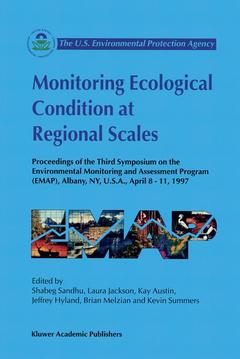Monitoring Ecological Condition at Regional Scales, Softcover reprint of the original 1st ed. 1998 Proceedings of the Third Symposium on the Environmental Monitoring and Assessment Program (EMAP) Albany, NY, U.S.A., 8-11 April, 1997
Langue : Anglais
Coordonnateurs : Sandhu Shabeg S., Jackson Laura, Austin Kay, Hyland Jeffrey, Melzian Brian D., Summers Kevin

The Environmental Monitoring and Assessment Program was created by EPA to develop the capability for tracking the changing conditions of our natural resources and to give environmental policy the advantages ofa sound scientific understanding of trends. Former EPA Administrators recognized early that contemporary monitoring programs could not even quantify simple unknowns like the number of lakes suffering from acid rain, let along determine if national control policies were benefiting these lakes. Today, adding to acidification impacts are truly complex problems such as determining the effects of climate change, of increases in ultraviolet light, toxic chemicals, eutrophication and critical habitat loss. Also today, the Government Performance and Results Act seeks to have agencies develop performance standards based on results rather than simply on levels of programmatic activities. The charge to EMAP of ecosystems is, therefore, the same today as it was a with respect to measuring the condition decade ago. We welcome the increasing urgency for sound scientific monitoring methods and data by efforts to protect and improve the environment. Systematic nationwide monitoring of natural resources is more than anyone program can accomplish, however. In an era of declining budgets, it is crucial that monitoring programs at all levels of government coordinate and share environmental data. EMAP resources are dwarfed by the more than $500 million spent on federal monitoring activities each year.
Preface; G. Veith. Environmental Monitoring and Research Initiative: A Priority Activity for the Committee on Environmental and Natural Resources; D. Pryor, et al. Environmental Data in Decision Making in EPA Regional Offices; S.L. Laskowski, F.W. Kutz. Development and Validation of Ecological Indicators: An ORD Approach; W.S. Fisher. A Zooplankton-N:P-Ratio Indicator for Lakes; R.S. Stemberger, E.K. Miller. Implications of Seasonal and Regional Abundance Patterns of Daphnia on Surface Water Monitoring and Assessment; F.B. Taub, C.D. Wiseman. The Role of Biological Indicators in a State Water Quality Management Process; C.O. Yoder, E.T. Rankin. Maryland Biological Stream Survey: Development of a Fish Index of Biotic Integrity; N. Roth, et al. Diatom Indicators of Stream and Wetland Stressors in a Risk Management Framework; R.J. Stevenson. The Occurrence and Impact of Sedimentation in Central Pennsylvania Wetlands; D.H. Wardrop, R.P. Brooks. Towards a Regional Index of Biological Integrity: The Example of Forested Riparian Ecosystems; R.P. Brooks, et al. A Bird Community Index of Biotic Integrity for the Mid-Atlantic Highlands; T.J. O'Connell, et al. Acid Runoff Caused Fish Loss as an Early Warning of Forest Decline; W.E. Sharpe, M.C. Demchik. Forest Integrity at Anthropogenic Edges: Air Pollution Disrupts Bioindicators; M.G. Glenn, et al. Common Patterns of Ecosystem Breakdown under Stress; D.J. Rapport, et al. Vegetation, Soil, and Animal Indicators of Rangeland Health; W.G. Whitford, et al. Monitoring Changes in Stressed Ecosystems Using Spatial Patterns of Ant Communities; M.S. Nash, et al. Parasites of Fish as Indicators of Environmental Stress; J.H. Landsberg, et al. Relating Benthic Infaunal Community Structure to Environmental Variables in Estuaries Using Nonmetric Multidimensional Scaling and Similarity Analysis; G. McRae, et al. Seed Clam Growth: An Alternative Sediment Bioassay Developed During EMAP in the Carolinian Province; A.H. Ringwood, C.J. Keppler. Benthic Biological Processes and EH as a Basis for a Benthic Index; W.R. Davis, et al. State of the Estuaries in the Mid-Atlantic Region of the United States; J.F. Paul, et al. A Framework for a Delaware Inland Bays Environmental Classification; K.S. Price. Maryland Biological Stream Survey: A State Agency Program to Assess the Impact of Anthropogenic Stresses on Stream Habitat Quality and Biota; R. Klauda, et al. Assessment of the Condition of Agricultural Lands in Five Mid-Atlantic States; A.S. Hellkamp, et al. An Interactive, Spatial Inventory of Environmental Data in the Mid-Atlantic Region; L.E. Jackson, M.P. Gant. Sediment Quality of Estuaries in the Southeastern U.S.; J.L. Hyland, et al. Evaluation of R- EMAP Techniques for the Measurement of Ecological Integrity of Streams in Washington State's Coast Range Ecoregion; J. White, G. Merritt. Site Access and Sample Frame Issues for R-EMAP Central Valley, California, Stream Assessment; R.K. Hall, et al. Linking Monitoring and Effects Research: EMAP's Intensive Site Network Program; J.K. Summers, K.E. Tonnessen. Determining the Causes of Benthic Condition; V.D. Engle, J.K. Summers. A Regional Analysis of Lake Acidification Trends for the Northeastern U.S., 1982-1994; J.L. Stoddard, et al. Regional Land Cover Characterization Using Landsat Thematic Mapper Data and Ancillary Data Sources; J.E. Vogelmann, et al. Managing Scientific Data: The EMAP Approach; S.S. Hale, et al. Exploring Environmental Data in a Highly Imme
This volume presents the proceedings of a symposium on the Environmental Monitoring and Assessment Program (EMAP), held in Albany, NY, USA, in April, 1997. A research program of the U.S. Environmental Protection Agency, EMAP has been advancing the state of the science in ecological indicator development, statistical sampling design, landscape characterization, and other tools of environmental monitoring since the program's inception in the late 1980s. EMAP's goal is to develop and demonstrate the science necessary to monitor status and trends in the condition of ecological resources at multiple spatial and temporal scales. These proceedings feature the latest research on ecological indicators, plus results from seven years of EMAP monitoring in estuarine, forest, and freshwater ecosystems.
Date de parution : 10-2013
Ouvrage de 603 p.
16x24 cm
Disponible chez l'éditeur (délai d'approvisionnement : 15 jours).
Prix indicatif 52,74 €
Ajouter au panierThèmes de Monitoring Ecological Condition at Regional Scales :
© 2024 LAVOISIER S.A.S.



